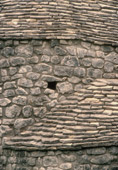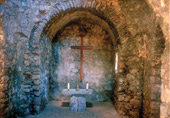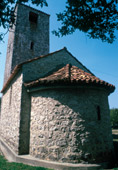OLD CROATIAN HERITAGE
Oh Our Lady Mary, take the souls
Of our brothers and sisters and pray
To your charitable son to forgive our sins.
From Pojubice, A letter honoured to the Mother of God
 Church of Saint Lucy, Jurandvor
Church of Saint Lucy, Jurandvor
The Benedictines (Glagolithic monks) constructed a new church and
the Saint Lucia Abbey on the remains of a Roman villa (between the
11th and 12th centuries). Today this is one of the most important
Croatian sacral constructions due to the unique find within (1851)
of the Baška tablet (dating back to the second half of the 11th
century), ˝the Croatian baptismal certificate˝. This is one of the
oldest findings (along with the Plomin tablet, the Krk tablet, and
the Valun tablet) of the Croatian language written in stone as a
carved monument. The Baška tablet, which “marks the beginning of
Croatian literature”, is a written in script in the transitional
style between rounded into angular Glagolithic script, and speaks of
the generosity of King Zvonimir, the ˝Croatian King˝, the Church of
Saint Lucy and the construction of the church. This tablet contains
the first records of the Croatian name in the Croatian language. A
copy of the tablet was installed at the place where the original was
found, in the stone barrier – septum – which separates the priest in
the sanctuary from the followers. The original is today kept in the
atrium of the main building of the Croatian Academy of Arts and
Science in Zagreb.
A massive bell tower was added (in the Romantic style) to the façade
of the church; the bell tower has a square foundation (the tower
dates back to 14th century) and on the left side of the tower is a
carved Croatian coat of arms. On the southern side of the church
nave, the Chapel of Our Lady of the Rosary, Our Lady of Luzara (15th
century) was constructed.
Next to the church is an archaeological park, which was completely
renovated in 2000.
The main celebration here is on the Feast of the Blessed Virgin Mary
of the Rosary, Ruzarija (7 October, blessing of flowers) and the
Feast of Saint Lucy (13 December). On Saint Lucy, the special
tradition is that after the mass, the locals throw small pieces of
bread from the bell tower.
info.tel. 051/860 184, 856 817, 856 953
www.tz-baska.hr,
tz-baska@ri.t-com.hr
This church is open from 1 April to 15 October from 10:00-14:00 and from 16:00-19:00, and in July and August from 9:00-13:00 and from 16:00-20:00. In the winter months, it is open for guided tours by appointment.
Church of Saint Chrysogonas (Krševan), Milohnići, Župa
Lindarići
On the northern side of the Island of Krk, above Čavlena Inlet, in a
forested and solitary location
once an agricultural region, we find the Church of Saint Chrysogonas
(approximately 1100), ˝small as a toy, but as monumental as a
Cathedral˝. One cannot explain the impression at first glance, or
any other view of this stone trefoil construction, which is full of
harmony and vaulted apses. The church can be reached via the path
from the village of Milohnići (approximately
4 kilometres) that begins near the Glavotok monastery.
Info tel: 051/ 862 032, 221 414
Church of Saint Donatus, Punat
 At the base of the bay
Puntarska draga, at the crossroads for Kornić and Punat, is the tiny but monumental trefoil Church of Saint Donatus (9th century).
Its large dome is of monumental importance.
Through the many centuries, this church has faced much adversity, damage and destruction,
however, it was restored in the middle of the last century. The first archive information about the church dates back only to the 16th century.
The church interior even today fascinates with its uniqueness and atmosphere, and it is assumed that the walls were once adorned with mosaics and frescos,
though today there are no traces of these.
At the base of the bay
Puntarska draga, at the crossroads for Kornić and Punat, is the tiny but monumental trefoil Church of Saint Donatus (9th century).
Its large dome is of monumental importance.
Through the many centuries, this church has faced much adversity, damage and destruction,
however, it was restored in the middle of the last century. The first archive information about the church dates back only to the 16th century.
The church interior even today fascinates with its uniqueness and atmosphere, and it is assumed that the walls were once adorned with mosaics and frescos,
though today there are no traces of these.
info. tel. 051/854 148, 854 970
 Church of Saint Vitus, Dobrinj
Church of Saint Vitus, Dobrinj
In the village of Sveti Vid in the Dobrinj parish,
the field road leads towards the small Church of Saint Vitus, with its impressive bell tower.
In appearance, it resembles the Church of Saint Lucy at Jurandvor and it belongs to the same period. Thanks to the donation by the
“glorius Dragoslav”, the church of Saint Vitus emphasizes its history with a complete date (1 January 1100). The noble Dragoslav donated the
church and the large accompanying lands to the Krk Bishop who, according to the laws of the time, in taking possession of the donated estate,
handed it over with all its lands, rights and responsibilities. Standing out in the field, surrounded by dry stone walls, is the bell tower on the
church facade, through which we pass to enter the church. The bell tower had the task of being both a watchtower and a place for signalization.
Throughout the year, the greatest celebration
is held on the Feast of Saint Vitus (15 June).
info. tel. 051/ 848 118, 852 107

